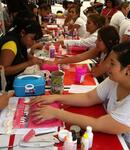

Researchers
BACKGROUND
Youth with Hope is the first large-scale vocational training program implemented in Mexico. The program aims at increasing educational engagement and attainment, employability and labor market mobility among 15-30 year olds. The situation of youth education and employment in Zapopan, located in the state of Jalisco in Western Mexico, resembles the national crisis. According to official figures, in the municipality of Zapopan at least 20% of the population between 15 and 24 years old are neither studying nor working. Further, in marginalized neighborhoods of Zapopan, the number of youth gangs increased significantly in the last five years.
As an effort to reinsert youth in the education-to-employment path, the municipal government of Zapopan, launched a vocational training program in 2013 for 15-30 year olds who are not attending formal education institutions and live in Zapopan. Participants enroll in tuition-free courses, contracted to private higher education institutions. About 210 courses are offered on trades and careers in technical and vocational fields. Students can choose one course per semester, and they are allowed to enroll in up to three courses.
The student population of Youth with Hope is very diverse. About 8,000 youths are enrolled in the program. Among those, 63% are women, 40% are under 21 years old, and 30% live in medium to highly marginalized urban and suburban areas where street gangs are present.
PARTNERS
The Stanford International Crime and Violence Lab is conducting an impact evaluation of Youth with Hope. Youth with Hope is a public-funded program run by the government of Zapopan. This pioneering policy initiative was designed and implemented in response to the major educational and employment challenges affecting young people.
While the main purpose of Youth with Hope is to increase educational attainment and employability, government officials running this vocational program have made an important effort to target teenagers and young adults living in violent and poor neighbors with the aim of reducing youth gang involvement, criminal behavior and drug use. Hence, our study will also evaluate if the program helps at decreasing alcohol and drug use and reducing social ties with gangs.
METHODS
Using panel data at the individual level, this study will evaluate the short and long term effects of the program on employment and educational attainment, relevant non-cognitive behaviors and skills, and youth access to new networks of potential mentors and post-training employment opportunities.
In terms of methods, this quasi-experimental design study takes advantage of the fact that only residents of Zapopan, Jalisco are eligible to participate in the program. We will select a comparison group of individuals living in nearby municipalities who have not received the intervention. To addresses program selectivity on measured and unmeasured characteristics and to deal with the fact that differences in outcomes might arise because participants and nonparticipants reside in different local labor markets, we will implement a diff-in-diff matching strategy. Further, we will estimate heterogeneous effects by gender, age, and socio-economic status.
STATUS
Evidence from our study will be an important contribution to the literature. There is limited research on the effects of youth training models in developing countries and practically non-existent studies for Latin America. Given Youth with Hope’s potential for replication and transferability to other Mexican states and developing countries, this impact evaluation study is of particular interest among policy-makers in Mexico and Latin America.
